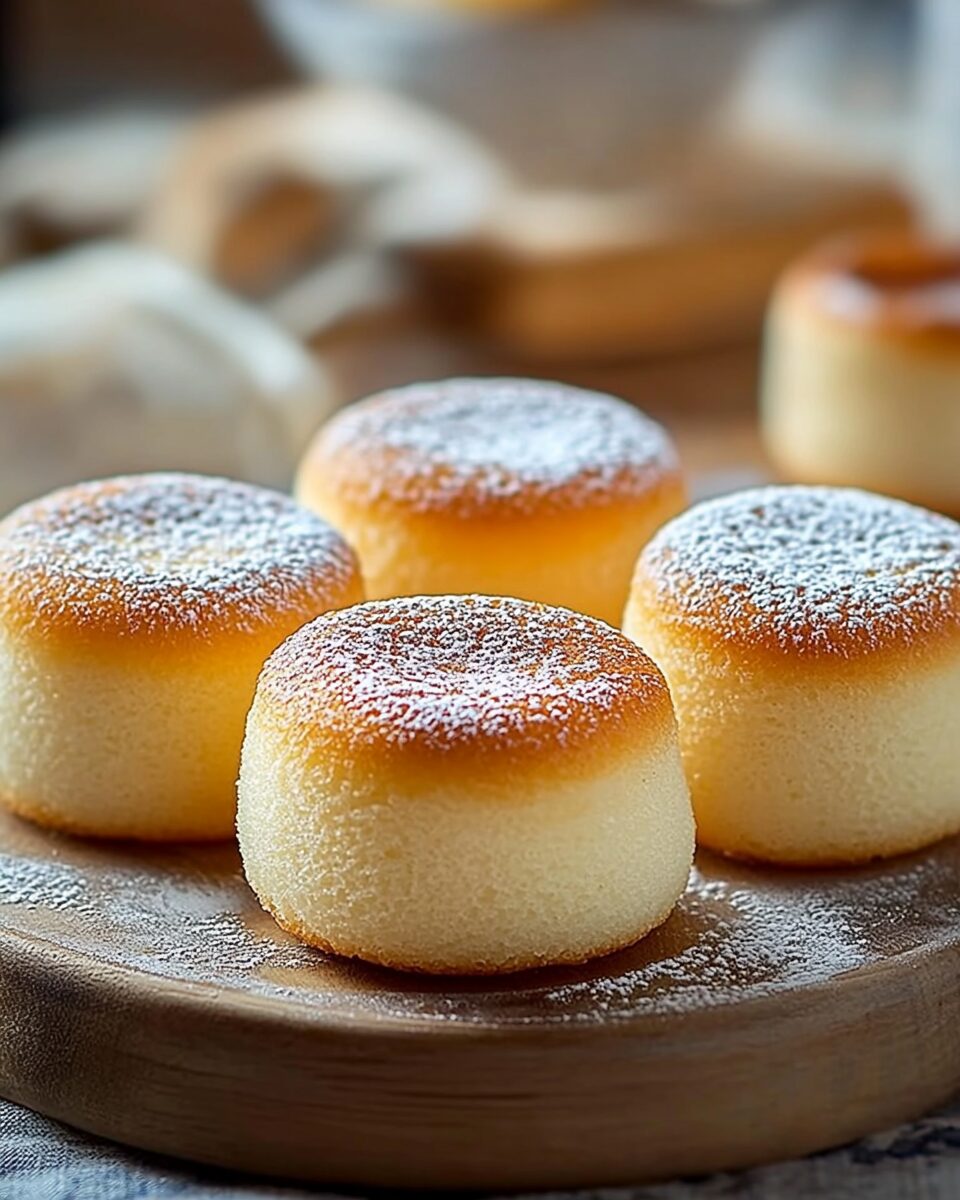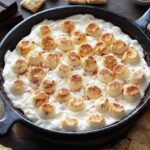Mini Chinese Sponge Cakes are light, fluffy treats that melt in your mouth, offering a delicate sweetness. Often enjoyed with tea, these soft cakes are a traditional favorite in Chinese bakeries. Their airy texture and simple ingredients make them a delightful dessert or snack for any occasion.
FULL RECIPE
Ingredients
- Eggs
- Sugar
- Cake flour
- Baking powder
- Vanilla extract
- Vegetable oil
- Milk
- Salt
Directions
- Preheat the oven to the appropriate temperature, typically around 350°F (175°C).
- Grease a mini cake mold or line it with cupcake liners.
- In a large mixing bowl, beat the eggs and sugar until the mixture becomes pale, thick, and fluffy.
- Add vanilla extract for flavor.
- In a separate bowl, sift together the cake flour, baking powder, and salt.
- Gradually fold the dry ingredients into the egg mixture using a spatula, ensuring not to deflate the batter.
- Gently mix in the vegetable oil and milk until just combined.
- Pour the batter into the prepared molds, filling each cavity about three-quarters full.
- Bake for approximately 15-20 minutes, or until a toothpick inserted into the center comes out clean.
- Let the cakes cool before removing them from the molds. Serve plain or with a light dusting of powdered sugar.
Nutrition Facts
- Calories: 120-150 kcal
- Carbohydrates: 20-25g
- Protein: 3-4g
- Fat: 4-6g
- Sugar: 12-15g
- Sodium: 50-100mg
Texture and Flavor Profile
Mini Chinese Sponge Cakes are renowned for their soft, fluffy texture and mildly sweet flavor. The delicate crumb and light airiness result from the well-aerated batter, which incorporates plenty of air during the mixing process. Unlike denser cakes, these sponge cakes have a tender bite and a slightly moist interior. The simple flavors of vanilla and eggs are prominent, making them a perfect pairing for tea or coffee.
Cultural Significance
These cakes are a beloved part of Chinese culinary traditions, often served during celebrations and festive occasions. Mini sponge cakes are especially popular in dim sum restaurants, where they are enjoyed as a light dessert or mid-meal treat. They symbolize happiness and prosperity, often making an appearance at weddings and family gatherings.
Perfect Occasions to Serve
Mini Chinese Sponge Cakes are ideal for afternoon tea, family get-togethers, or celebratory events. Their elegant simplicity makes them a great addition to dessert platters. They can also be used as a base for layered desserts, topped with fresh fruits, cream, or a drizzle of syrup for a more indulgent experience.
Pairing Suggestions
These cakes complement a variety of beverages, especially traditional Chinese teas like jasmine or oolong. Their subtle sweetness also pairs well with milk tea, black coffee, or even a cold glass of milk. For a sophisticated touch, serve them with fruit preserves, lemon curd, or a dollop of whipped cream.
Tips for Achieving the Perfect Sponge Cake
To ensure your mini sponge cakes come out light and airy, it’s essential to beat the eggs and sugar thoroughly until they are pale and fluffy. This step incorporates air, which provides the cake with its signature texture. Additionally, folding the flour mixture gently into the egg mixture helps retain the air bubbles. Avoid over-mixing to prevent a dense cake.
Common Mistakes to Avoid
One of the most common mistakes when making sponge cakes is deflating the batter by over-mixing. This results in a flat, dense cake. Another issue is improper temperature control. Ensure your oven is preheated to the correct temperature for even baking. Lastly, using stale baking powder can lead to poor rising, so always check the expiration date.
Storage and Shelf Life
Mini Chinese Sponge Cakes are best enjoyed fresh on the day they are baked. However, they can be stored in an airtight container at room temperature for up to two days. For longer storage, refrigerate them for up to a week or freeze for up to three months. Simply thaw and warm them slightly before serving.
Variations and Additions
While the classic version is simple and light, you can easily customize mini sponge cakes. Add citrus zest for a refreshing twist or mix in finely chopped nuts for added texture. You can also incorporate matcha powder for an earthy flavor or a splash of almond extract for a nutty undertone.
Health Considerations
Compared to richer desserts, mini sponge cakes are relatively low in fat and calories. They contain a moderate amount of sugar, making them a suitable treat for those watching their calorie intake. You can also make healthier versions using whole wheat flour, reducing sugar, or substituting oil with applesauce.
Gluten-Free and Dairy-Free Options
For a gluten-free version, substitute the cake flour with a gluten-free flour blend. Ensure the baking powder is also gluten-free. For a dairy-free alternative, replace the milk with almond, soy, or oat milk. Coconut oil can be used instead of vegetable oil for a slightly tropical flavor.
Presentation Ideas
To elevate the appearance of your mini sponge cakes, consider dusting them with powdered sugar or cocoa powder. Fresh fruit, edible flowers, or gold leaf accents can also add a touch of elegance. Serve them in decorative cupcake liners for a charming presentation at parties.
History of Chinese Sponge Cakes
Chinese Sponge Cakes have roots in traditional Chinese baking methods influenced by Western culinary techniques. The use of eggs, sugar, and flour was popularized during the colonial era, and these cakes became a staple in Chinese bakeries. Today, they remain a cherished part of the Chinese dessert repertoire.
Regional Variations
While the mini version is widely loved, different regions in China offer unique takes on sponge cakes. In Hong Kong, steamed sponge cakes known as Ma Lai Go are popular, characterized by their caramel-like sweetness. Other areas may incorporate coconut milk or pandan for a tropical flair.
Sustainability in Baking
Using local and organic ingredients for your sponge cakes can significantly reduce your carbon footprint. Choose sustainably sourced eggs and flour from responsible producers. Additionally, avoid food waste by repurposing leftover sponge cakes into trifles or cake pops.
Troubleshooting Guide
If your cakes turn out too dense, it may be due to insufficient air in the batter or over-mixing. If they collapse after baking, check for proper oven temperature calibration and ensure the cakes are fully cooked before removing them. Using fresh ingredients also contributes to the best results.
Serving Size and Portions
Mini Chinese Sponge Cakes are typically bite-sized, making them perfect for serving in multiples. Depending on the mold size, the recipe can yield between 12 to 24 cakes. A serving of 2-3 mini cakes is generally appropriate for dessert or a snack.
Calorie Control and Substitutions
For those seeking to reduce the calorie count, try replacing sugar with natural sweeteners like stevia or monk fruit. You can also reduce the amount of oil by using unsweetened applesauce or Greek yogurt.
Conclusion
Mini Chinese Sponge Cakes are a delightful, airy dessert that brings joy to any table. Their simplicity, versatility, and light sweetness make them a timeless classic. Whether enjoyed on their own, paired with tea, or dressed up with creative toppings, these cakes are sure to impress. Try making them for your next gathering or simply enjoy them as a satisfying treat for yourself.






